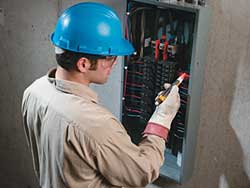Verifying Lockout/Tagout Electrically Safe Status
These practices are recommended for non-electricians who are working in electrical environments.
- By Duane Smith
- Nov 01, 2005
 LOCKOUT/TAGOUT procedures specify the steps electricians must follow to remove power from an electrical circuit or panel and to lock out and tag the panel or circuit so no one can re-energize it while work is in progress. An increasing number of specialty contractors, ranging from health inspectors to thermographers, must work around electrical panels and exposed circuits.
LOCKOUT/TAGOUT procedures specify the steps electricians must follow to remove power from an electrical circuit or panel and to lock out and tag the panel or circuit so no one can re-energize it while work is in progress. An increasing number of specialty contractors, ranging from health inspectors to thermographers, must work around electrical panels and exposed circuits.
For their own safety, these contractors and anyone else who may be exposed to live voltages should:
- Understand lockout/tagout procedures.
- Know how to verify power has been removed from the environment before beginning work, especially if live circuits may be nearby.
Contractors in these circumstances should carry a non-contact voltage detector in their shirt pocket to verify their work environment is safe in terms of exposure to live circuits or conductors. These non-contact detectors are relatively inexpensive, and industrial models are safety rated up to 1,000 volts AC.
About Lockout/Tagout
Lockout/tagout electrical disconnect principles and procedures are described in industry standards such as NFPA 70E, Standard for Electrical Safety in the Workplace, which is published by the National Fire Protection Association.
NFPA 70E requires those working on exposed conductors and circuit components operating at 50 volts or more to use lockout/ tagout devices and procedures and be properly trained. The document also outlines specific circumstances when work on live circuits is permitted and sets approach boundaries for both qualified and unqualified personnel.
Standard Lockout/Tagout Process
Conducted by the electrician
1. Open disconnecting device(s) for each source of power supply.
2. Visually verify that all blades of the disconnecting devices are fully open or that circuit breakers are in the fully disconnected position.
3. Use a voltage detector or other test tool to verify the panel/circuit is de-energized.
Verifying Lockout/Tagout
Conducted by the non-electrician
1. Visually verify the electrician has applied lockout/tagout devices in accordance with a documented and established policy and that he/she has declared the area or equipment electrically safe.
2. Test your voltage detector on a known live circuit to make sure it works.
3. Use your voltage detector to test the surrounding equipment cabinets and circuit panels (covers, not wiring) to ensure everything is de-energized or grounded.
Only after the area has been declared electrically safe should you:
4. Test each phase conductor or circuit breaker for the absence of voltage. The wand should read no live electricity on each test.
5. After each test, check the voltage detector wand again on the known live circuit.
Only after you have verified the absence of voltage should you begin work on the equipment to be serviced or in the area where exposed electrical conductors are present.
This article appeared in the November 2005 issue of Occupational Health & Safety.
This article originally appeared in the November 2005 issue of Occupational Health & Safety.
About the Author
Duane Smith, senior support engineer for the Fluke DMM Group, is a Fluke specialist on digital multimeters. A 30-year veteran who has seen electrical test tools evolve from benchtop to hand held, Smith trains test tool users, troubleshoots field applications, and helps develop new Fluke DMMs and electrical testers. To contact him, email [email protected].